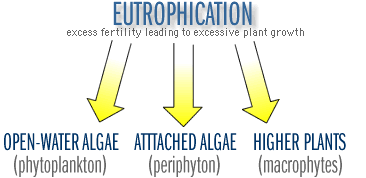 |
 |

Figure 22
WATER QUALITY IMPACTS ASSOCIATED WITH EUTROPHICATION
- Noxious algae (scums, blue-greens, taste and odor, visual)
- Excessive macrophyte growth (loss of open water)
- Loss of clarity (secchi depth goes down)
- Possible loss of macrophytes (via light limitation by algae and periphyton)
- Low dissolved oxygen (loss of habitat for fish and fish food)
- Excessive organic matter production (smothering eggs and bugs)
- Blue-green algae inedible by some zooplankton (reduced food chain efficiency)
- "Toxic" gases (ammonia, H2S) in bottom water (more loss of fish habitat)
- Possible toxins from some species of blue-green algae
- Chemical treatment by lakeshore homeowners or managers may result (copper, diquat, 2,4-D, etc.)
- Drinking water degradation from treatment disinfection byproducts
- Carcinogens, such as chloroform (from increased organic matter reacting with disinfectants like chlorine)